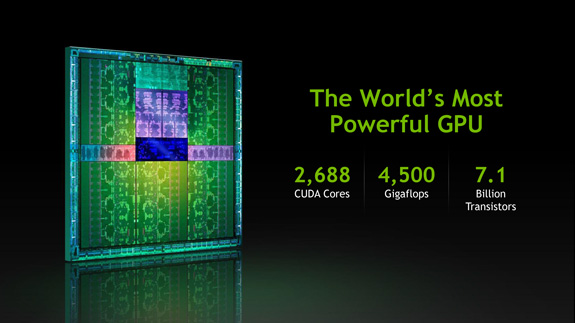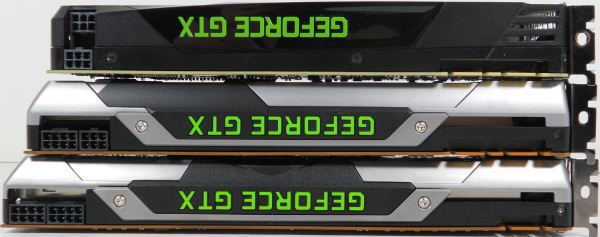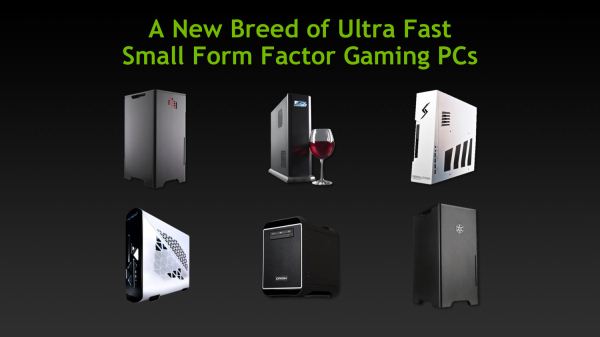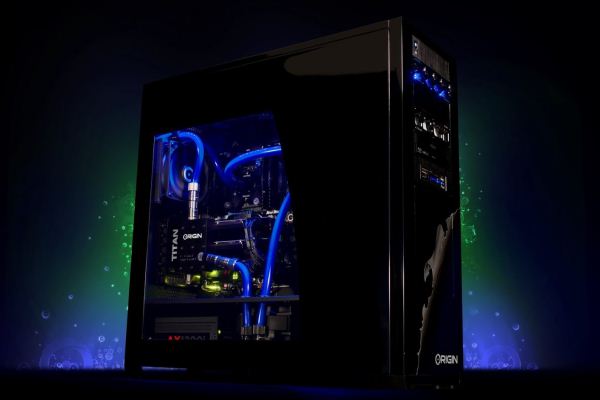NVIDIA's GeForce GTX Titan, Part 1: Titan For Gaming, Titan For Compute
by Ryan Smith on February 19, 2013 9:01 AM ESTWho’s Titan For, Anyhow?
Having established performance expectations, let’s talk about where Titan fits into NVIDIA’s product stack. First and foremost, though Titan is most certainly geared in part as a gaming video card (and that’s largely how we’ll be looking at it), that’s not the only role it serves. Titan is also going to be NVIDIA’s entry-level compute card. We’ll dive more into why that is in a bit in our feature breakdown, but the biggest factor is that for the first time on any consumer-level NVIDIA card, double precision (FP64) performance is uncapped. That means 1/3 FP32 performance, or roughly 1.3TFLOPS theoretical FP64 performance. NVIDIA has taken other liberties to keep from this being treated as a cheap Tesla K20, but for lighter workloads it should fit the bill.
As compared to the server and high-end workstation market that Tesla carves out, NVIDIA will be targeting the compute side of Titan towards researchers, engineers, developers, and others who need access to (relatively) cheap FP64 performance, and don’t need the scalability or reliability that Tesla brings. To that end Titan essentially stands alone in NVIDIA’s product stack; the next thing next to a FP64-constrained consumer card is the much more expensive Tesla K20.

Far more complex will be the gaming situation. Titan will not be pushing anything down in NVIDIA’s product stack, rather NVIDIA’s product stack will be growing up to accompany Titan. Like the GTX 690, NVIDIA is going to position Titan as a premium/luxury product, releasing it at the same $999 price point. GTX 690 itself will continue to exist at the same $999 price point, meanwhile GTX 680 will continue at its current price point of roughly $450.
Continuing the GTX 690 analogies, Titan will not only be sharing in GTX 690’s price point, but also in its design principles and distribution. This means Titan is a well-built card with its housing composed primarily of metals, with the same kind of luxury finish as the GTX 690. On the distribution side of things Asus and EVGA are once again NVIDIA’s exclusive partners for North America, and they will essentially be distributing reference Titan cards. In time we will see some specialized variation, with water-cooling in particular being an obvious route for EVGA to go. Factory overclocks are also on the table.
With the above in mind, it goes without saying that while GTX 690 had some historical precedence in its price, the same cannot be said for Titan. The price of NVIDIA’s top-tier single-GPU video cards hovered around $500 for the GeForce 400/500 series, and while they attempted to launch at $650 for the GTX 280, the launch of the Radeon HD 4870 quickly brought that price down to earth. As such this will be the most expensive single-GPU product out of NVIDIA yet.

Top To Bottom: GTX 680, GTX Titan, GTX 690
Ultimately NVIDIA is not even going to try to compete on a price-performance basis with Titan. There are a number of potential reasons for this – ranging from the competitive landscape to yields to needs for GK110 GPUs elsewhere within NVIDIA – and all of those reasons are probably true to some extent. Regardless, NVIDIA believes that like the GTX 690 they can sell Titan as a luxury product, and hence $999. The GTX 680 and below will compose NVIDIA’s more traditional price-performance competitive fare.
As to be expected from such a price, NVIDIA’s marketing department will be handling Titan in a similar fashion as they did GTX 690. This not only includes reiterating the fact that Titan is intended to be a luxury product, but also focusing on markets where luxury products are accepted, and where Titan in particular makes sense.
Perhaps not surprisingly, with $999 video cards the makeup of consumers shifts away from both traditional big-box OEMs and DIY builders, and towards boutique builders. Boutique builders are essentially already in the business of providing luxury computers, offering an outlet for luxury buyers who need not spend their time building their own computer, and want something of higher quality than what the typical OEM provides. As such while Titan will be sold on the open market just as like any other card, NVIDIA tells us that they expect a lot of those buyers are going to be the boutiques.
For Titan in particular, NVIDIA is going to be focusing on two boutique computer concepts, reflecting the blower design of Titan as opposed to the front/back exhausting design of the GTX 690. The first concept will be SFF PCs, where blowers are a necessity due to a lack of space (and often, a lack of heavy sound dampening), and where such cards can draw fresh air in from outside the chassis.
On the other end of the spectrum will be the ultra-enthusiast market where one Titan isn’t enough, and even two may come up short. Again thanks to the fact that it’s a blower, Titan can easily be fit in an ATX motherboard for tri-SLI operation, which NVIDIA envisions not just as the ultimate gaming computer, but the ultimate NV/3D Surround computer in particular. Multi-monitor gaming with graphically intensive games can quickly nullify the performance of even a single Titan card, so tri-SLI is NVIDIA’s solution to driving three monitors as well as one Titan can drive one monitor. At the same time however, NVIDIA intends to showcase that a tri-SLI system doesn’t need to be loud, despite the cramped conditions and despite the 750W+ that 3 Titans will pull, thanks to the high quality construction of the cards. Tri-SLI has been possible for a number of years, but NVIDIA believes with Titan in particular they have a solid grip on the heat and noise concerns it typically comes with.
To that end, as part of the Titan launch NVIDIA has shipped out a number of boutique systems in either a SFF or tri-SLI full tower configuration to reviewers, in order to show off their usage concepts in completed and well-constructed systems. Anand received a SFF Tiki from Falcon Northwest, while I have received a tri-SLI equipped Genesis from Origin PC. Like Titan itself we can’t talk about the performance of these systems, but we’ll be able to go into greater detail on Thursday when the complete NDA lifts. In the meantime we’ve been able to post a few impressions, which we’ve put up on their respective articles.
Moving on, with a $999 launch price NVIDIA’s competition will be rather limited. The GTX 690 is essentially a companion product; NVIDIA’s customers can either get the most powerful single-GPU card NVIDIA offers in a blower design, or an alternative design composed of two lesser GPUs in SLI, in a front and rear exhausting design. The GTX 690 will be the faster card, but at a higher TDP and with the general drawbacks of SLI. On the other hand Titan will be the more consistent card, the lower TDP card, the easier to cool card, but also the slower card. Meanwhile though it’s not a singular product, the GTX 680 SLI will also be another option, offering higher performance, higher TDP, more noise, and a cheaper price tag of around $900.
As for AMD, with their fastest single-GPU video card being the 7970 GHz Edition, offering performance closer to the GTX 680 than Titan, Titan essentially sits in a class of its own on the single-GPU front. AMD’s competition for Titan will be the 7970GE in CrossFire, and then the officially unofficial 7990 family, composed of the air-cooled PowerColor 7990, and the closed loop water-cooled Asus Ares II. But with NVIDIA keeping GTX 690 around, these are probably closer competitors to the multi-GPU 690 than they are the single-GPU Titan.
Finally, let’s talk launch availability. By scheduling the launch of Titan during the Chinese New Year, NVIDIA has essentially guaranteed this is a delayed availability product. Widespread availability is expected on the 25th, though cards may start popping up a couple of days earlier. NVIDIA hasn’t gone into depth for launch quantities, but they did specifically shoot down the 10,000 card rumor; this won’t be a limited run product and we don’t have any reason at this time to believe this will be much different from the GTX 690’s launch (tight at first, but available and increasingly plentiful).
| February 2013 GPU Pricing Comparison | |||||
| AMD | Price | NVIDIA | |||
| $1000 | GeForce GTX Titan/690 | ||||
| (Unofficial) Radeon HD 7990 | $900 | ||||
| Radeon HD 7970 GHz Edition | $450 | GeForce GTX 680 | |||
| Radeon HD 7970 | $390 | ||||
| $350 | GeForce GTX 670 | ||||
| Radeon HD 7950 | $300 | ||||












157 Comments
View All Comments
chizow - Friday, February 22, 2013 - link
Um, GF100/110 are absolutely the same league as this card. In the semiconductor industry, size = classification. This is not the first 500+mm^2 ASIC Nvidia has produced, the lineage is long and distinguished:G80, GT200, GT200b, GF100, GF110.
*NONE* of these GPUs cost $1K, only the 8800Ultra came anywhere close to it at $850. All of these GPUs offered similar features and performance relative to the competition and prevailing landscape. Hell, GT200 was even more impressive as it offered a 512-bit memory interface.
Increase in number of transistors is just Moore's law, that's just expected progress. If you don't know the material you're discussing please refrain from commenting, thank you.
CeriseCogburn - Sunday, February 24, 2013 - link
Wait a minute doofus, you said the memory cost the same, and it's cheap.You entirely disregarded the more than double the core transistor footprint, the R&D for it, the yield factor, the high build quality, and the new and extra top tier it resides in, not to mention it's awesome features the competition did not develop and does not have, AT ALL.
4 monitors out of the box, Single card 3d and surround, extra monitor for surfing, target frame rate, TXAA, no tesselation lag, and on and on.
Once a product breaks out far from the competitions underdeveloped and undeveloped failures, it EARNS a price tier.
You're living in the past, you're living with the fantasy of zero worldwide inflation, you'r living the lies you've told yourself and all of us about the last 3 top tier releases, all your arguments exposed in prior threads for the exaggerated lies they were and are, and the Charlie D RUMORS all you of the this same ilk repeat, even as you ignore the absolute time years long DEV time and entire lack of production capability with your tinfoil hat whine.
The market has changed you fool. There was a SEVERE SHORTAGE in the manufacturing space (negating your conspiracy theory entirely) and still there's pressure, and nVidia has developed a large range of added features the competition is entirely absent upon.
You didn't get the 680 for $350 (even though you still 100% believe Charlie D's lie filled rumor) and you're not getting this for your fantasy lie price either.
CeriseCogburn - Sunday, February 24, 2013 - link
NONE had the same or much bigger die sizes.NONE had 7.1 BILLION engineer traced research die points.
NONE had the potential downside low yield.
NONE had the twice plus expensive ram in multiples more attached.
NONE is the amount of truth you told.
Stuka87 - Tuesday, February 19, 2013 - link
Common sense would say nVidia is charging double what they should be.384bit memory is certainly not a reason for high cost as AMD uses it in the 79x0 series chips. A large die adds to cost, but the 580 had a big die as well (520mm2), so that cant be the whole reason for the high cost (the GK110 does have more transistors).
So it comes down to nVidia wanted to scalp customers.
As for your comments on AMD, what proof do you have that AMD has nothing else in the works? Not sure what crap you are referring too. I have had no issues with my AMD cards or their drivers (Or my nVidias for that matter). Just keep on hating for no reason.
AssBall - Tuesday, February 19, 2013 - link
You speak of common sense, but miss the point. When have you ever bought a consumer card for the pre-listed MSRP? These cards will sell to OEM's for compute and to enthusiasts via Nvidia's partners for much less.So it comes down to "derp Nvidia is a company that wants to make money derp".
Calling someone a hater for unrealistic reasons is much less of an offense than being generally an idiot.
TheJian - Wednesday, February 20, 2013 - link
A chip with 7.1B transistors is tougher to make correctly than 3B. Which card has 6GB of 6ghz memory from AMD that's $500 with this performance? 7990 is $900-1000 with 6GB and is poorly engineered compared to this (nearly double the watts, two slots more heat etc etc).This is why K20 costs $2500. They get far few of these perfect than much simpler chips. Also as said before, engineering these are not free. AMD charges less you say? Their bottom line for last year shows it too...1.18B loss. That's why AMD will have no answer until the end of the year. They can't afford to engineer an answer now. They just laid of 30% of their workforce because they couldn't afford them. NV hired 800 people last year for new projects. You do that with profits, not losses. You quit giving away free games or go out of business.
Let me know when AMD turns a profit for a year. I guess you won't be happy until AMD is out of business. I think you're hating on NV for no reason. If they were anywhere near scalping customers they should have record PROFITS but they don't. Without Intel's lawsuit money (300mil a year) they'd be making ~1/2 of what they did in 2007. You do understand a company has to make money to stay in business correct?
If NV charged 1/2 the price for this they would be losing probably a few hundred on each one rather than probably a $200 profit or so.
K20 is basically the same card for $2500. You're lucky their pricing it at $1000 for what you're getting. Amazon paid $2000ea for 10000 of these as K20's. You think they feel robbed? So by your logic, they got scalped 20,000 times since they paid double the asking here with 10000 of them?...ROFL. OK.
What it comes down to is NV knows how to run a business, while AMD knows how to run one into the ground. AMD needs to stop listening to people like you and start acting like NV or they will die.
AMD killed themselves the day they paid 3x the price they should have for ATI. Thank Hector Ruiz for that. He helped to ruin Motorola too if memory serves...LOL. I love AMD, love their stuff, but they run their business like idiots. Kind of like Obama runs the country. AMD is running a welfare business (should charge more, and overpays for stuff they shouldn't even buy), obama runs a welfare country, and pays for crap like solyndra etc he shouldn't (with our money!). Both lead to credit downgrades and bankruptcy. You can't spend your way out of a visa bill. But both AMD and Obama think you can. You have to PAY IT OFF. Like NV, no debt. Spend what you HAVE, not what you have to charge.
Another example. IMG.L, just paid triple what they should have for the scrap of MIPS. I think this will be their downfall. They borrowed 22million to pay 100mil bid for mips. It was worth 30mil. This will prove to be Imaginations downfall. That along with having chip sales up 90% but not charging enough to apple for them. They only made 30mil for 6 MONTHS! Their chip powers all of apples phones and tablets graphics! They have a hector ruiz type running their company too I guess. Hope they fire him before he turns them into AMD. Until Tegra4 they have the best gpu on a soc in the market. But they make 1/10 of what NV does. Hmmm...Wrong pricing? Apple pockets 140Bil over the life of ipad/iphone...But IMG.L had to borrow 22mil just to buy a 100mil company? They need to pull a samsung and raise prices 20% on apple. NV bought icera with 325mil cash...Still has 3.74B in the bank (which btw is really only up from 2007 because of Intel's 300mil/yr, not overcharging you).
CeriseCogburn - Sunday, February 24, 2013 - link
Appreciate it. Keep up the good work, as in telling the basic facts called the truth to the dysfunctional drones.no physx
no cuda
no frame rate target (this is freaking AWESOME, thanks nVidia)
no "cool n quiet" on the fly GPU heat n power optimizing max fps
no TXAA
no same game day release drivers
EPIC FAIL on dual cards, yes even today for amd
" While it suffers from the requirement to have proper game-specific SLI profiles for optimum scaling, NVIDIA has done a very good job here in the past, and out of the 19 games in our test suite, SLI only fails in F1 2012. Compare that to 6 out of 19 failed titles with AMD CrossFire."
http://www.techpowerup.com/reviews/NVIDIA/GeForce_...
nVidia 18 of 19, 90%+ GRADE AAAAAAAAAA
amd 13 of 19 < 70% grade DDDDDDDDDD
Iketh - Tuesday, February 19, 2013 - link
please drag yourself into the street and stone yourselfCeriseCogburn - Sunday, February 24, 2013 - link
LOL awww, now that wasn't very nice... May I assume you aren't in the USA and instead in some 3rd world hole with some 3rd world currency and economy where you can't pitch up a few bucks because there's no welfare available ? Thus your angry hate filled death wish ?MrSpadge - Tuesday, February 19, 2013 - link
Don't worry.. price will drop if they're actually in a hurry to sell them.